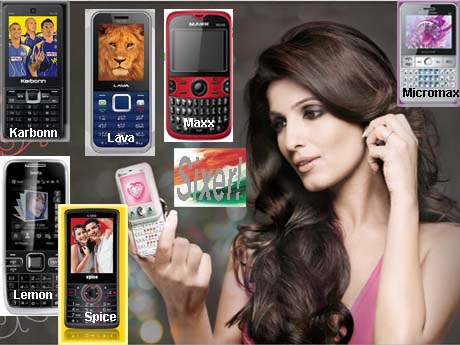
Local brands Max, Micromax, Karbonn, Lava, Lemon & Spice take 14% revenue share from global biggies
Indians are discovering Indian mobile phones: In the last fiscal year, they increasingly bought handsets offered by Indian companies, giving the top seven local makers a 14 percent share by revenue of the total mobile handset market in the country. This is the most interesting finding in the annual Voice and Data 100 Indian Telecom Survey conducted by CyberMedia’s telecom journal. The previous survey put the Indian companies’ share are just around 4 percent.
The Indian brands included Micromax (4.1% handset market share by revenue), Spice (3.9%), Karbonn (3%), Lava (1.1%), Lemon (1%) and Max (0.9%). However their offerings are not made-in-India in the strict sense – like most handsets sold anywhere, they they are sourced from China or Taiwan but branded in India
Why this small but significant lurch from dominant global brands like Nokia?
“Low prices for perceived high-end features,” feels Voice&Data Chief Editor Prasanto K Roy. “You get all-QWERTY Blackberry look-alikes complete with trackball, and even dual-SIM phones, for Rs 5,000. We saw demand rising for dual-SIM phones last year, but the market leaders had few offerings there. And while Nokia has many low-cost models, they are relatively sparse on features.”
“Where they may fall short is in applications and functionality, user interface and experience, and, often, quality of construction, solidity and robustness,” Prasanto adds . “But with the short life cycles of handsets today, many buyers are willing to experiment.”
The mobile handset market grew 4.2% by revenue during FY 2009-10 (compared with 7.9% in 2008-09, and 11.9% in 2007-08). The low revenue growth hides the large numbers sold, but reflects the fact that most sales are of low-priced handsets, and that the average sale price been dropping each year.
Around 108 million mobile phones were sold in the country during 2009-10, adding up to Rs 270 billion in sales, up from Rs 259 billion the previous year.
The country added 192 million mobile subscribers in the fiscal. A large number of subscribers have more than one SIM card, and an increasing number use dual-SIM phones.
The Voice&Data100 annual survey on handset is based on the revenue of telecom equipment suppliers, including GSM and CDMA handset vendors.
Handset major Nokia remained the market leader with 52% share, despite a 15% revenue dip to Rs 141 billion (down from Rs 165.67 billion in 2008-09). The Finnish giant's share was gobbled up by the Indian-brand handsets, and by Samsung. Nokia launched 22 devices during the year, selling them though over 200,000 retail outlets across the country (with 45% in rural India), and supporting them with over 700 service centers across 400 towns and cities. But its services thrust diluted its focus on handsets.
Samsung remained the second largest handset vendor, with 17.4% market share, followed by LG at 5.9%. Sony Ericsson slipped last year, with very few options in the low- and mid-range handset segments.
Footnote: With 3G services on offer ( BSNL is giving away free 3G SIMS to its landline customers in some metros) , there are hardly any 3G phones to be had --except in the premium category. Could this be the next wave of oppoprtunity for 'Indian' handsets?
June 26 2010